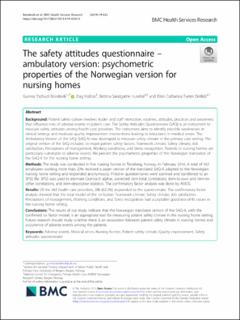| dc.description.abstract | Patient safety culture involves leader and staff interaction, routines, attitudes, practices and awareness that influence risks of adverse events in patient care. The Safety Attitudes Questionnaire (SAQ) is an instrument to measure safety attitudes among health care providers. The instrument aims to identify possible weaknesses in clinical settings and motivate quality improvement interventions leading to reductions in medical errors. The Ambulatory Version of the SAQ (SAQ-A) was developed to measure safety climate in the primary care setting. The original version of the SAQ includes six major patient safety factors: Teamwork climate, Safety climate, Job satisfaction, Perceptions of management, Working conditions, and Stress recognition. Patients in nursing homes are particularly vulnerable to adverse events. We present the psychometric properties of the Norwegian translation of the SAQ-A for the nursing home setting.
Methods
The study was conducted in five nursing homes in Tønsberg, Norway, in February 2016. A total of 463 employees working more than 20% received a paper version of the translated SAQ-A adapted to the Norwegian nursing home setting and responded anonymously. Filled-in questionnaires were scanned and transferred to an SPSS file. SPSS was used to estimate Cronbach alphas, corrected item-total correlations, item-to-own and item-to-other correlations, and item-descriptive statistics. The confirmatory factor analysis was done by AMOS.
Results
Of the 463 health care providers, 288 (62.2%) responded to the questionnaire. The confirmatory factor analysis showed that the total model of the six factors Teamwork climate, Safety climate, Job satisfaction, Perceptions of management, Working conditions, and Stress recognition had acceptable goodness-of-fit values in the nursing home setting.
Conclusions
The results of our study indicate that the Norwegian translated version of the SAQ-A, with the confirmed six factor model, is an appropriate tool for measuring patient safety climate in the nursing home setting. Future research should study whether there is an association between patient safety climate in nursing homes and occurrence of adverse events among the patients. | |

